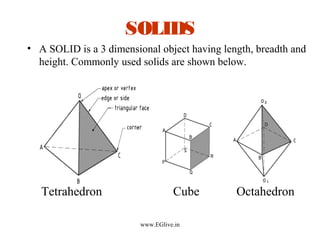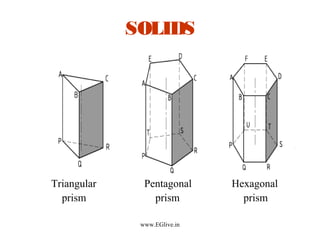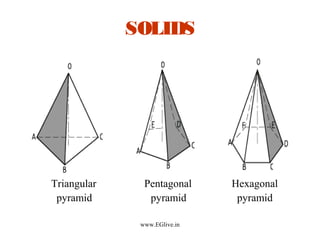Lesson 4-solids-i
Download as PPT, PDF1 like2,316 views
This document discusses projections of solids in engineering drawing. It defines different types of solids like cubes, prisms, and pyramids. It explains the six positions a solid can be placed in for projections and how to visualize the projections. Examples are provided on drawing top, front, and side views of rectangular prisms, hexagonal prisms, and triangular prisms based on their position. Tips are given on drawing visible and hidden edges in different views. The document aims to help understand projections of solids.
1 of 17
Downloaded 156 times

















Recommended
Lesson 5-solids-ii



Lesson 5-solids-iieglive
Ėý
This document discusses methods for projecting solids when the axis is inclined to the horizontal plane (HP) and parallel to the vertical plane (VP). It describes the change of position method, which involves first drawing the projections with the axis perpendicular to HP, then tilting the front view to the correct orientation. Several examples demonstrate applying this method to a pentagonal prism, square pyramid, cylinder, and cone. Tips are provided for determining which edges are visible or hidden in the projections. The document is intended to teach engineering graphics concepts related to multi-view projections of 3D objects.Lesson 6-solids-iii



Lesson 6-solids-iiieglive
Ėý
This document discusses the projection of solids with axes inclined to the vertical plane (VP) and parallel to the horizontal plane (HP). It describes the change of position method for drawing such projections in two steps: 1) assume the axis is perpendicular to VP and parallel to HP and draw front and top views; 2) reproduce the top view at the required inclination and project the front view. It provides examples of applying this method to draw the projections of various solids, including prisms, cylinders, pyramids, and cones, oriented with different inclinations. Tips are also given for determining which edges are visible or hidden in the projections.New lesson 1 points and lines - i



New lesson 1 points and lines - ieglive
Ėý
This document provides an overview of projections of points and lines in engineering drawings. It discusses the principles of projection and defines projection planes. It then demonstrates how to project and draw the top and front views of points and lines in different positions and orientations relative to the projection planes. Examples are given of drawing the projections of points and lines, including marking the traces. Tips are provided for solving problems involving projecting inclined lines. The document recommends reference books on engineering graphics and drawing.Lesson 7-sections-i



Lesson 7-sections-ieglive
Ėý
This document discusses sections of solids and how to draw them. It defines what a section is when a plane cuts through a solid. It provides instructions on how to draw sections, including marking new corners and projecting points to other views. It then gives 5 examples of drawing sections of different solids like prisms, pyramids, cylinders and cones in different orientations. It concludes by providing some tips on drawing sections and listing reference books.Lesson 4 Projections of Solids - Part I



Lesson 4 Projections of Solids - Part IJeyapoovan Thangasamy
Ėý
This document discusses projections of solids in engineering drawing. It explains that a solid can be positioned in six different orientations relative to reference planes. Based on the solid's orientation, its top view, front view, or side view is drawn first and the other views are projected from it. Examples are provided of drawing the projections of rectangular prisms, hexagonal prisms, and triangular prisms in different orientations. Tips are given for determining which edges are visible or hidden in different views.Lesson 8-sections-ii



Lesson 8-sections-iieglive
Ėý
This document discusses sections of cones and provides examples of drawing sections of cones cut by different planes. It begins by explaining that the true shape of a cone section can be a circle, ellipse, parabola, hyperbola, or triangle depending on how the cutting plane intersects the cone. It then provides five examples of drawing front, top, and true shape views of cones cut by various planes, and explains how to determine the true shape in each case. The document concludes by providing tips for drawing cone sections, such as how the true shape is affected by the orientation of the cutting plane.Lesson 5 Projections of Solids - Part II



Lesson 5 Projections of Solids - Part IIJeyapoovan Thangasamy
Ėý
Projections of a solid kept inclined to one reference plane (HP or VP). Change of position method, Change of reference line method. Lesson 2-lines-ii



Lesson 2-lines-iieglive
Ėý
This document discusses methods for projecting straight lines that are inclined to both the horizontal and vertical planes. It describes the rotating line method, which involves 4 steps: 1) drawing the front view with the line parallel to the vertical plane, 2) drawing the top view with the line parallel to the horizontal plane, 3) drawing the locus of the other end of the line, and 4) rotating the views to the required position along the locus. The rotating trapezoidal plane method uses trapezoidal planes containing the line and its projections to determine the true length and inclinations. Special cases and tips for solving problems are also provided.Lesson 6 Projections of Solids - Part III



Lesson 6 Projections of Solids - Part IIIJeyapoovan Thangasamy
Ėý
Projections of a solid kept inclined to both reference planes (HP and VP). Change of position method, Change of reference line method. Lesson 1 Projections of Points and Straight Lines - Part I



Lesson 1 Projections of Points and Straight Lines - Part IJeyapoovan Thangasamy
Ėý
Projections of point, Projections of a Straight line kept in different positions with reference to HP and VPLesson 2 Projections of Straight Lines - Part II



Lesson 2 Projections of Straight Lines - Part IIJeyapoovan Thangasamy
Ėý
Projections of a Straight line kept inclined to both HP and VP. Rotating line method and Rotating Trapezoidal Method Lesson 3 Projectons of planes



Lesson 3 Projectons of planesJeyapoovan Thangasamy
Ėý
Types of plane surfaces, Projections of a plane kept in different positions with reference to HP and VPLesson 3-planes



Lesson 3-planeseglive
Ėý
The document discusses the projections of planes and their traces. It defines a plane as a two-dimensional object with length and breadth. It explains how to determine the front, top, and side views of a plane based on its orientation relative to the horizontal and vertical planes. It provides examples of determining the projections of different shaped planes in different orientations, such as a square plane perpendicular to the horizontal plane, a triangular plane inclined to the vertical plane, and a hexagonal plane perpendicular to both planes. It concludes by providing tips for solving problems on plane projections and listing reference books.Lesson 8 Section of Solids - Part II



Lesson 8 Section of Solids - Part IIJeyapoovan Thangasamy
Ėý
Sections of solids after a plane cut the solid and remove some portion of it. Apparent section and true shape of section. Lesson 7 Section of Solids - Part I



Lesson 7 Section of Solids - Part IJeyapoovan Thangasamy
Ėý
Sections of solids after a plane cut the solid and remove some portion of it. Apparent section and true shape of section. Lesson 10 Development of surfaces - Part II



Lesson 10 Development of surfaces - Part IIJeyapoovan Thangasamy
Ėý
Development of surfaces of solids, Radial line method to draw development of lateral surfaces of any type of pyramid or cone.Lesson 9-development-of-surfaces-i



Lesson 9-development-of-surfaces-ieglive
Ėý
This document discusses the development of surfaces for prisms and cylinders. It defines surface development as opening out the faces and bases of an object onto a flat plane. For prisms and cylinders, the parallel line method is used, involving drawing parallel lines the length of the base perimeter and marking faces between them. It provides examples of developing various prisms and cylinders, describing the steps like drawing projections, marking new points, and completing the development. Tips are given like using a 2H pencil first and projecting points accurately. References for further reading are also included.Eg4 n



Eg4 nParth Sahu
Ėý
This document discusses development of surfaces and isometric projection. It begins by introducing development of surfaces, including methods of development and developing the surfaces of right solids like cubes, prisms, cylinders, pyramids and cones. It then introduces isometric projection, including isometric axes, lines, planes and scale. It provides examples of developing different objects and drawing isometric views.Lesson 9 Development of surfaces - Part I



Lesson 9 Development of surfaces - Part IJeyapoovan Thangasamy
Ėý
Development of surfaces of solids, Parallel line method to draw development of lateral surfaces of any type of prism or cylinder.Lesson 11-isometric-projections-i



Lesson 11-isometric-projections-ieglive
Ėý
This document discusses isometric projection and how to draw isometric views of objects. It explains that isometric projection shows all three dimensions of an object using three intersecting axes at 120 degree angles. True dimensions are used for isometric views of single solids, while isometric projections of combinations of solids use compressed isometric dimensions. Common techniques for drawing isometric views, like the box method and 4-center method for circles, are described. Several step-by-step examples demonstrate how to apply these techniques to draw isometric views of prisms, cylinders, and cut pyramids. Tips are provided on what details to include or omit in isometric drawings.Lesson 10-development-of-surfaces-ii



Lesson 10-development-of-surfaces-iieglive
Ėý
This document provides examples and instructions for developing the surfaces of various solids using the radial line method. It begins with an overview of developing a square pyramid by opening up the triangular faces and drawing them as separate triangles connected by the base square. Several examples are then given of developing specific solids like pyramids, cones, and funnels that have been cut by various planes. Guidance is provided on drawing the projections, marking new points where edges intersect the cutting plane, and using radial lines to accurately trace the remaining portions on development. Tips are also included to first sketch the development lightly and then project and darken remaining sections.Lesson 13 Perspective projection



Lesson 13 Perspective projectionJeyapoovan Thangasamy
Ėý
Perspective projection of solids, pictorial representation of solids. Preparing realistic drawing of an object. Unit iv section of solids



Unit iv section of solidsganesasmoorthy raju
Ėý
introduction of engineering graphics ,projection of points,lines,planes,solids,section of solids,development of surfaces,isometric projection,perspective projectionLesson 11 Isometric Projection - Part I



Lesson 11 Isometric Projection - Part IJeyapoovan Thangasamy
Ėý
Isometric view and Isometric projection of solids, three dimensional representation of solids. Box method to draw isometric drawing. Lesson 12-isometric-projections-ii



Lesson 12-isometric-projections-iieglive
Ėý
This document discusses isometric projection and provides examples of how to draw isometric projections of various objects. It explains that isometric projection uses an isometric scale of 0.82 times the true length. It then provides step-by-step instructions for drawing isometric projections of a frustum of a cone, hexagonal prism with a cone, square pyramid on a cylinder, and a sphere on a cube. It concludes by providing some tips for drawing isometric projections, such as using isometric dimensions and representing spheres as circles.Development of surfaces of solids



Development of surfaces of solidsUtsav Chopra
Ėý
Development of surfaces of solids - By : http://www.hackingmonk.com
Download Link: http://safemylinks.com/d/c828e76c66Lesson 3-planes



Lesson 3-planeseglive
Ėý
The document discusses the projections of planes and their traces. It explains that a plane is a 2D object with length and breadth. The projections of a plane depend on its position relative to the horizontal and vertical planes. When a plane is perpendicular to the horizontal plane and parallel to the vertical plane, its front view is its true shape and size, and its top view is a line. When a plane is perpendicular to the vertical plane and parallel to the horizontal plane, its top view is its true shape and size, and its front view is a line. Several examples are provided to demonstrate how to draw the projections of planes in different positions.Lesson 9-development-of-surfaces-i



Lesson 9-development-of-surfaces-ieglive
Ėý
This document discusses the development of surfaces for prisms and cylinders. It defines surface development as opening out the faces and bases of an object onto a flat plane. For prisms and cylinders, the parallel line method is used, in which two lines equal to the base perimeter are drawn parallel at a distance equal to the axis length. Faces are then marked between the lines. Several examples demonstrate how to develop the surfaces of prisms and cylinders when cut by planes. Tips are provided for accurately marking new points and completing the development.Isometric



Isometricshishir97
Ėý
The document discusses isometric projections and how to draw isometric views. It defines isometric projection as a type of axonometric projection where all planes are equally inclined to the plane of projection. It provides principles for constructing isometric projections of cubes and other objects. The key aspects are that all edges are equally foreshortened, dimensions are kept the same in isometric views, and examples are given for drawing isometric views of various objects like rectangles, triangles, circles, prisms, pyramids, cylinders, and spheres.Chapter 3 multiview drawings



Chapter 3 multiview drawingsTigistWondimneh
Ėý
The document provides information on multi-view drawings and orthographic projection. It discusses how multi-view drawings use orthographic projection to show the front, rear, top, bottom, right and left views of an object arranged in a standard order. First or third angle projection can be used, where the layout of views differs depending on the projection system used. Guidelines are provided for selecting views and how objects may require one, two, or three views depending on their complexity. The document also covers topics such as projecting planer and non-planer surfaces, intersections, center lines, and hidden line practices.More Related Content
What's hot (18)
Lesson 6 Projections of Solids - Part III



Lesson 6 Projections of Solids - Part IIIJeyapoovan Thangasamy
Ėý
Projections of a solid kept inclined to both reference planes (HP and VP). Change of position method, Change of reference line method. Lesson 1 Projections of Points and Straight Lines - Part I



Lesson 1 Projections of Points and Straight Lines - Part IJeyapoovan Thangasamy
Ėý
Projections of point, Projections of a Straight line kept in different positions with reference to HP and VPLesson 2 Projections of Straight Lines - Part II



Lesson 2 Projections of Straight Lines - Part IIJeyapoovan Thangasamy
Ėý
Projections of a Straight line kept inclined to both HP and VP. Rotating line method and Rotating Trapezoidal Method Lesson 3 Projectons of planes



Lesson 3 Projectons of planesJeyapoovan Thangasamy
Ėý
Types of plane surfaces, Projections of a plane kept in different positions with reference to HP and VPLesson 3-planes



Lesson 3-planeseglive
Ėý
The document discusses the projections of planes and their traces. It defines a plane as a two-dimensional object with length and breadth. It explains how to determine the front, top, and side views of a plane based on its orientation relative to the horizontal and vertical planes. It provides examples of determining the projections of different shaped planes in different orientations, such as a square plane perpendicular to the horizontal plane, a triangular plane inclined to the vertical plane, and a hexagonal plane perpendicular to both planes. It concludes by providing tips for solving problems on plane projections and listing reference books.Lesson 8 Section of Solids - Part II



Lesson 8 Section of Solids - Part IIJeyapoovan Thangasamy
Ėý
Sections of solids after a plane cut the solid and remove some portion of it. Apparent section and true shape of section. Lesson 7 Section of Solids - Part I



Lesson 7 Section of Solids - Part IJeyapoovan Thangasamy
Ėý
Sections of solids after a plane cut the solid and remove some portion of it. Apparent section and true shape of section. Lesson 10 Development of surfaces - Part II



Lesson 10 Development of surfaces - Part IIJeyapoovan Thangasamy
Ėý
Development of surfaces of solids, Radial line method to draw development of lateral surfaces of any type of pyramid or cone.Lesson 9-development-of-surfaces-i



Lesson 9-development-of-surfaces-ieglive
Ėý
This document discusses the development of surfaces for prisms and cylinders. It defines surface development as opening out the faces and bases of an object onto a flat plane. For prisms and cylinders, the parallel line method is used, involving drawing parallel lines the length of the base perimeter and marking faces between them. It provides examples of developing various prisms and cylinders, describing the steps like drawing projections, marking new points, and completing the development. Tips are given like using a 2H pencil first and projecting points accurately. References for further reading are also included.Eg4 n



Eg4 nParth Sahu
Ėý
This document discusses development of surfaces and isometric projection. It begins by introducing development of surfaces, including methods of development and developing the surfaces of right solids like cubes, prisms, cylinders, pyramids and cones. It then introduces isometric projection, including isometric axes, lines, planes and scale. It provides examples of developing different objects and drawing isometric views.Lesson 9 Development of surfaces - Part I



Lesson 9 Development of surfaces - Part IJeyapoovan Thangasamy
Ėý
Development of surfaces of solids, Parallel line method to draw development of lateral surfaces of any type of prism or cylinder.Lesson 11-isometric-projections-i



Lesson 11-isometric-projections-ieglive
Ėý
This document discusses isometric projection and how to draw isometric views of objects. It explains that isometric projection shows all three dimensions of an object using three intersecting axes at 120 degree angles. True dimensions are used for isometric views of single solids, while isometric projections of combinations of solids use compressed isometric dimensions. Common techniques for drawing isometric views, like the box method and 4-center method for circles, are described. Several step-by-step examples demonstrate how to apply these techniques to draw isometric views of prisms, cylinders, and cut pyramids. Tips are provided on what details to include or omit in isometric drawings.Lesson 10-development-of-surfaces-ii



Lesson 10-development-of-surfaces-iieglive
Ėý
This document provides examples and instructions for developing the surfaces of various solids using the radial line method. It begins with an overview of developing a square pyramid by opening up the triangular faces and drawing them as separate triangles connected by the base square. Several examples are then given of developing specific solids like pyramids, cones, and funnels that have been cut by various planes. Guidance is provided on drawing the projections, marking new points where edges intersect the cutting plane, and using radial lines to accurately trace the remaining portions on development. Tips are also included to first sketch the development lightly and then project and darken remaining sections.Lesson 13 Perspective projection



Lesson 13 Perspective projectionJeyapoovan Thangasamy
Ėý
Perspective projection of solids, pictorial representation of solids. Preparing realistic drawing of an object. Unit iv section of solids



Unit iv section of solidsganesasmoorthy raju
Ėý
introduction of engineering graphics ,projection of points,lines,planes,solids,section of solids,development of surfaces,isometric projection,perspective projectionLesson 11 Isometric Projection - Part I



Lesson 11 Isometric Projection - Part IJeyapoovan Thangasamy
Ėý
Isometric view and Isometric projection of solids, three dimensional representation of solids. Box method to draw isometric drawing. Lesson 12-isometric-projections-ii



Lesson 12-isometric-projections-iieglive
Ėý
This document discusses isometric projection and provides examples of how to draw isometric projections of various objects. It explains that isometric projection uses an isometric scale of 0.82 times the true length. It then provides step-by-step instructions for drawing isometric projections of a frustum of a cone, hexagonal prism with a cone, square pyramid on a cylinder, and a sphere on a cube. It concludes by providing some tips for drawing isometric projections, such as using isometric dimensions and representing spheres as circles.Development of surfaces of solids



Development of surfaces of solidsUtsav Chopra
Ėý
Development of surfaces of solids - By : http://www.hackingmonk.com
Download Link: http://safemylinks.com/d/c828e76c66Similar to Lesson 4-solids-i (19)
Lesson 3-planes



Lesson 3-planeseglive
Ėý
The document discusses the projections of planes and their traces. It explains that a plane is a 2D object with length and breadth. The projections of a plane depend on its position relative to the horizontal and vertical planes. When a plane is perpendicular to the horizontal plane and parallel to the vertical plane, its front view is its true shape and size, and its top view is a line. When a plane is perpendicular to the vertical plane and parallel to the horizontal plane, its top view is its true shape and size, and its front view is a line. Several examples are provided to demonstrate how to draw the projections of planes in different positions.Lesson 9-development-of-surfaces-i



Lesson 9-development-of-surfaces-ieglive
Ėý
This document discusses the development of surfaces for prisms and cylinders. It defines surface development as opening out the faces and bases of an object onto a flat plane. For prisms and cylinders, the parallel line method is used, in which two lines equal to the base perimeter are drawn parallel at a distance equal to the axis length. Faces are then marked between the lines. Several examples demonstrate how to develop the surfaces of prisms and cylinders when cut by planes. Tips are provided for accurately marking new points and completing the development.Isometric



Isometricshishir97
Ėý
The document discusses isometric projections and how to draw isometric views. It defines isometric projection as a type of axonometric projection where all planes are equally inclined to the plane of projection. It provides principles for constructing isometric projections of cubes and other objects. The key aspects are that all edges are equally foreshortened, dimensions are kept the same in isometric views, and examples are given for drawing isometric views of various objects like rectangles, triangles, circles, prisms, pyramids, cylinders, and spheres.Chapter 3 multiview drawings



Chapter 3 multiview drawingsTigistWondimneh
Ėý
The document provides information on multi-view drawings and orthographic projection. It discusses how multi-view drawings use orthographic projection to show the front, rear, top, bottom, right and left views of an object arranged in a standard order. First or third angle projection can be used, where the layout of views differs depending on the projection system used. Guidelines are provided for selecting views and how objects may require one, two, or three views depending on their complexity. The document also covers topics such as projecting planer and non-planer surfaces, intersections, center lines, and hidden line practices.Development of surfaces of solids



Development of surfaces of solidsSumit Chandak
Ėý
1. A cone with a 50mm base diameter and 70mm axis is cut by a section plane inclined at 45 degrees to the horizontal plane through the base end of an end generator.
2. The projections, sectional views, true shape of the section, and development of the remaining solid are drawn.
3. Key features included the section plane cutting the cone, projections showing the cut portion, and the true shape and development unfolding the remaining surface.Section and development



Section and developmentgtuautonomous
Ėý
1. The document provides instructions for sectioning solids, developing surfaces of solids, and intersections of solids. It includes definitions of terms like section plane and sectioning.
2. Illustrations show how to determine the true shape of sections and develop the surfaces of remaining parts of solids that have been cut by a section plane.
3. The document contains examples of typical section planes and resulting shapes for various solids like cones, pyramids, and prisms. It also provides practice problems for using these techniques.Lesson 13-perspective-projection



Lesson 13-perspective-projectioneglive
Ėý
This document discusses perspective projection and provides examples of how to draw perspective views of objects. Perspective projection involves drawing three-dimensional objects as they appear to the human eye using a station point and picture plane. It describes the key elements used, such as the ground plane, station point, picture plane, and visual rays. Examples are provided to demonstrate how to draw perspective views of basic shapes like pyramids, blocks, and cubes using either the visual ray method or vanishing point method. Tips are included on identifying visible and invisible edges and completing the perspective projection drawing.Engg Drawing ppt



Engg Drawing pptssuser14dd14
Ėý
This document discusses projection of solids in engineering drawing. It describes different types of solids like cubes, cylinders, prisms, and pyramids. It explains two methods of drawing projections - reproducing views and using auxiliary planes. It provides examples of how to draw projections of various solids like prisms, cones, pyramids in different orientations using these methods. It also describes how to determine apparent length and angle from true length and angle, and vice versa.Lesson 1-points-and-lines-i (1)



Lesson 1-points-and-lines-i (1)eglive
Ėý
This document provides an overview of projections of points and lines in engineering drawings. It discusses the principles of projection and defines projection planes. It then demonstrates how to project and draw the top and front views of points and lines in different positions and orientations relative to the projection planes. Examples are given of drawing the projections of points and lines, including marking the traces. Tips are provided for solving problems involving projecting inclined lines. The document recommends reference books on engineering graphics and drawing.Lesson 1-points-and-lines-i (1)



Lesson 1-points-and-lines-i (1)Thinesh Ananth
Ėý
This document provides an overview of projections of points and lines in engineering drawings. It discusses the principles of projection and defines projection planes. It then demonstrates how to project and draw the top and front views of points and lines in different orientations, including perpendicular, parallel, and inclined positions relative to the projection planes. Examples are given with step-by-step instructions on how to draw the projections and mark the traces of lines. Tips are provided for solving common projection problems. The document aims to teach the fundamental concepts and techniques for creating multiview drawings of points and lines.Lesson 1-points-and-lines-i (1)



Lesson 1-points-and-lines-i (1)eglive
Ėý
This document provides an overview of projections of points and lines in engineering drawings. It discusses the principles of projection and defines projection planes. It then demonstrates how to project and draw the top and front views of points and lines in different positions and orientations relative to the projection planes. Examples are given of drawing the projections of points and lines, including marking the traces. Tips are provided for solving problems involving projecting inclined lines. The document recommends reference books on engineering graphics and drawing.engineering-graphics.pdf



engineering-graphics.pdfHarikumarA4
Ėý
This document discusses sections and developments of solids. It begins by defining sectioning of a solid as cutting it with an imaginary cutting plane to understand its internal details. The cutting plane is called the section plane. It then discusses different types of section planes and their appearances in projections. Later it defines development as unfolding the lateral surfaces of a hollow solid to show its total surface area as a 2D shape. Various engineering applications of developments are listed. The document provides examples of typical section planes and shapes, and methods for developing different solids, sections and frustums. It concludes with sample problems demonstrating how to draw sections, developments and true shapes of cut solids.Engineering Graphics Projection of Solids.pptx



Engineering Graphics Projection of Solids.pptxPrashant Borakhede
Ėý
Description and problems based on projection of solidsprojection of solide



projection of solideChukka Nikhil Chakravarthy
Ėý
1. The document classifies solids into two groups - Group A solids have bases and tops of the same shape, while Group B solids have a base of some shape and just a point as a top.
2. Problems involving solids are solved in three steps: 1) assume the solid is standing on its base plane, 2) consider the solid's inclination, 3) consider any remaining inclination to draw the final views.
3. Key solids discussed include cylinders, cones, prisms, pyramids, tetrahedrons, and their dimensional parameters, positions of centers of gravity, and examples of how to draw their projections when resting, inclined, or freely suspended.Unit 6



Unit 6Chukka Nikhil Chakravarthy
Ėý
1) The document classifies solids into two groups - Group A solids have bases and tops of the same shape, while Group B solids have a base of some shape and just a point as a top.
2) Problems involving solids are solved in three steps - assuming the solid standing on a reference plane, drawing projections based on that, then considering additional inclinations.
3) Freely suspended solids have their center of gravity located at specific points along their axis depending on the solid type - cylinders and prisms have their CG at the midpoint, while cones and pyramids have their CG a quarter of the way from the base.6. Section of solids and development of surfaces.ppt



6. Section of solids and development of surfaces.pptAmitSolankiSVNIT
Ėý
This document provides information about sections of solids, development, and intersections in engineering drawing. It discusses how to section a solid using an imaginary cutting plane and the different types of section planes. Typical section planes and their resulting shapes are shown for different solids. Development is defined as unfolding the hollowed-out sheet of a solid to show its unfolded shape. Several examples of developments are provided for solids like prisms, cylinders, cones, pyramids, and frustums. The document also contains several problems demonstrating how to draw projections, sectional views, true shapes of sections, and developments for various solids that are cut by different section planes.Sections & Development of Surfaces_MAY 7 (3).pptx



Sections & Development of Surfaces_MAY 7 (3).pptxGosalaHarinathGowd
Ėý
1. A pentagonal prism with a 30mm base side and 50mm axis is resting on its base on the HP. One side of the base is perpendicular to the VP.
2. The prism is cut by a section plane inclined at 45 degrees to the HP, passing through the midpoint of the axis.
3. The development, true shape of the section, and sectional views (FV, TV, and side view) are drawn to show the remaining solid after cutting.Engineering garphics projection of solids



Engineering garphics projection of solidsPranav Kulshrestha
Ėý
This document contains information about various 3D shapes or solids. It divides solids into two groups: Group A includes cylinders and prisms which have bases and tops of the same shape, while Group B includes cones and pyramids which have a pointed top. The document provides details on the dimensional parameters, projections and solving problems related to different solids. It also discusses positions of the center of gravity for freely suspended solids.Recently uploaded (20)
Blockchain for Businesses Practical Use Cases & Benefits.pdf



Blockchain for Businesses Practical Use Cases & Benefits.pdf Yodaplus Technologies Private Limited
Ėý
Blockchain is revolutionizing industries by enhancing security, transparency, and automation. From supply chain management and finance to healthcare and real estate, blockchain eliminates inefficiencies, prevents fraud, and streamlines operations.
What You'll Learn in This Presentation:
1. How blockchain enables real-time tracking & fraud prevention
2. The impact of smart contracts & decentralized finance (DeFi)
3. Why businesses should adopt secure and automated blockchain solutions
4. Real-world blockchain applications across multiple industries
Explore the future of blockchain and its practical benefits for businesses!Webinar: LF Energy GEISA: Addressing edge interoperability at the meter



Webinar: LF Energy GEISA: Addressing edge interoperability at the meterDanBrown980551
Ėý
This webinar will introduce the Grid Edge Security and Interoperability Alliance, or GEISA, an effort within LF Energy to address application interoperability at the very edge of the utility network: meters and other distribution automation devices. Over the last decade platform manufacturers have introduced the ability to run applications on electricity meters and other edge devices. Unfortunately, while many of these efforts have been built on Linux, they havenât been interoperable. APIs and execution environment have varied from one manufacturer to the next making it impossible for utilities to obtain applications that they can run across a fleet of different devices. For utilities that want to minimize their supply chain risk by obtaining equipment from multiple suppliers, they are forced to run and maintain multiple separate management systems. Applications available for one device may need to be ported to run on another, or they may not be available at all.
GEISA addresses this by creating a vendor neutral specification for utility edge computing environments. This webinar will discuss why GEISA is important to utilities, the specific issues GEISA will solve and the new opportunities it creates for utilities, platform vendors, and application vendors. Big Data Analytics Quick Research Guide by Arthur Morgan (PREVIEW)



Big Data Analytics Quick Research Guide by Arthur Morgan (PREVIEW)Arthur Morgan
Ėý
This is a Quick Research Guide (QRG).
QRGs include the following:
- A brief, high-level overview of the QRG topic.
- A milestone timeline for the QRG topic.
- Links to various free online resource materials to provide a deeper dive into the QRG topic.
- Conclusion and a recommendation for at least two books available in the SJPL system on the QRG topic.
QRGs planned for the series:
- Artificial Intelligence QRG
- Quantum Computing QRG
- Big Data Analytics QRG (coming 2025)
- Spacecraft Guidance, Navigation & Control QRG (coming 2026)
- UK Home Computing & The Birth of ARM QRG (coming 2027)
Any questions or comments?
- Please contact Arthur Morgan at art_morgan@att.net.
100% human made.Agentic AI: The 2025 Next-Gen Automation Guide



Agentic AI: The 2025 Next-Gen Automation GuideThoughtminds
Ėý
Introduction to Agentic AI: Explains how it differs from traditional automation and its ability to make independent decisions.
Comparison with Generative AI: A structured comparison between Generative AI (content creation) and Agentic AI (autonomous action-taking).
Technical Breakdown: Covers core components such as LLMs, reinforcement learning, and cloud infrastructure that power Agentic AI.
Real-World Use Cases (2025 & Beyond): Examines how Agentic AI is transforming industries like insurance, healthcare, retail, finance, and cybersecurity.
Business Impact & ROI: Discusses case studies from Unilever, FedEx, and more, showcasing cost savings and operational efficiency improvements.
Challenges & Risks: Highlights bias, security threats, regulatory compliance, and workforce reskilling as critical challenges in AI adoption.
5-Step Implementation Strategy: A practical roadmap to help organizations integrate Agentic AI seamlessly.
Future Predictions (2025-2030): Forecasts on AI-driven workforce evolution, industry disruptions, and the rise of Quantum AI.Kickstart Your QA: An Introduction to Automated Regression Testing Tools



Kickstart Your QA: An Introduction to Automated Regression Testing ToolsShubham Joshi
Ėý
For teams eager to elevate their quality assurance practices, this guide offers an introductory look at automated regression testing tools. In the realm of software development, regression tests are vital to ensuring that recent code changes donât inadvertently break existing functionality. This article demystifies how automated regression testing tools function and why theyâre indispensable for maintaining software quality. It covers the basics of setting up automated tests, integrating these tests into your CI/CD pipelines, and choosing the right tool to match your projectâs needs. With clear explanations and actionable insights, youâll discover how these tools help reduce manual testing burdens and catch bugs early. The guide also highlights common challenges beginners face and offers practical solutions to overcome them. Whether youâre a QA professional or a developer stepping into the world of test automation, this resource will help you kickstart your journey toward more reliable, efficient, and scalable testing practices.
UiPath Automation Developer Associate Training Series 2025 - Session 1



UiPath Automation Developer Associate Training Series 2025 - Session 1DianaGray10
Ėý
Welcome to UiPath Automation Developer Associate Training Series 2025 - Session 1.
In this session, we will cover the following topics:
Introduction to RPA & UiPath Studio
Overview of RPA and its applications
Introduction to UiPath Studio
Variables & Data Types
Control Flows
You are requested to finish the following self-paced training for this session:
Variables, Constants and Arguments in Studio 2 modules - 1h 30m - https://academy.uipath.com/courses/variables-constants-and-arguments-in-studio
Control Flow in Studio 2 modules - 2h 15m - https:/academy.uipath.com/courses/control-flow-in-studio
âïļ For any questions you may have, please use the dedicated Forum thread. You can tag the hosts and mentors directly and they will reply as soon as possible. The Constructor's Digital Transformation Playbook: Reducing Risk With Technology



The Constructor's Digital Transformation Playbook: Reducing Risk With TechnologyAggregage
Ėý
https://www.professionalconstructorcentral.com/frs/27678427/the-constructor-s-digital-transformation-playbook--reducing-risk-with-technology
Reduce risk and boost efficiency with digital transformation in construction. Join us to explore how AI, automation, and data-driven insights can improve project safety and streamline operations.Getting Started with AWS - Enterprise Landing Zone for Terraform Learning & D...



Getting Started with AWS - Enterprise Landing Zone for Terraform Learning & D...Chris Wahl
Ėý
Recording: https://youtu.be/PASG0NTKUQA?si=1Ih7O9z0Lk0IzX9n
Welcome innovators! In this comprehensive tutorial, you will learn how to get started with AWS Cloud and Terraform to build an enterprise-like landing zone for a secure, low-cost environment to develop with Terraform. We'll guide you through setting up AWS Control Tower, Identity and Access Management, and creating a sandbox account, ensuring you have a safe and controlled area for learning and development. You'll also learn about budget management, single sign-on setup, and using AWS organizations for policy management. Plus, dive deep into Terraform basics, including setting up state management, migrating local state to remote state, and making resource modifications using your new infrastructure as code skills. Perfect for beginners looking to master AWS and Terraform essentials!Teaching Prompting and Prompt Sharing to End Users.pptx



Teaching Prompting and Prompt Sharing to End Users.pptxMichael Blumenthal (Microsoft MVP)
Ėý
How to teach M365 Copilot and M365 Copilot Chat prompting to your colleagues. Presented at the Advanced Learning Institute's "Internal Communications Strategies with M365" event on February 27, 2025. Intended audience: Internal Communicators, User Adoption Specialists, IT.Benchmark Testing Demystified: Your Roadmap to Peak Performance



Benchmark Testing Demystified: Your Roadmap to Peak PerformanceShubham Joshi
Ėý
Benchmark testing is the cornerstone of understanding your systemâs performance, and this guide breaks it down step-by-step. Learn how to design tests that simulate real-world conditions, measure key performance metrics, and interpret results effectively. This comprehensive roadmap covers everything from selecting the right tools to creating repeatable tests that help identify bottlenecks and optimize resource usage. Whether you're dealing with web applications, mobile apps, or enterprise software, this guide offers practical tips and real-life examples to ensure your system runs at peak efficiency.Transcript: AI in publishing: Your questions answered - Tech Forum 2025



Transcript: AI in publishing: Your questions answered - Tech Forum 2025BookNet Canada
Ėý
George Walkley, a publishing veteran and leading authority on AI applications, joins us for a follow-up to his presentation "Applying AI to publishing: A balanced and ethical approach". George gives a brief overview of developments since that presentation and answers attendees' pressing questions about AIâs impact and potential applications in the book industry.
Link to recording and presentation slides: https://bnctechforum.ca/sessions/ai-in-publishing-your-questions-answered/
Presented by BookNet Canada on February 20, 2025 with support from the Department of Canadian Heritage.THE BIG TEN BIOPHARMACEUTICAL MNCs: GLOBAL CAPABILITY CENTERS IN INDIA



THE BIG TEN BIOPHARMACEUTICAL MNCs: GLOBAL CAPABILITY CENTERS IN INDIASrivaanchi Nathan
Ėý
This business intelligence report, "The Big Ten Biopharmaceutical MNCs: Global Capability Centers in India", provides an in-depth analysis of the operations and contributions of the Global Capability Centers (GCCs) of ten leading biopharmaceutical multinational corporations in India. The report covers AstraZeneca, Bayer, Bristol Myers Squibb, GlaxoSmithKline (GSK), Novartis, Sanofi, Roche, Pfizer, Novo Nordisk, and Eli Lilly. In this report each company's GCC is profiled with details on location, workforce size, investment, and the strategic roles these centers play in global business operations, research and development, and information technology and digital innovation.Artificial Intelligence Quick Research Guide by Arthur Morgan



Artificial Intelligence Quick Research Guide by Arthur MorganArthur Morgan
Ėý
This is a Quick Research Guide (QRG).
QRGs include the following:
- A brief, high-level overview of the QRG topic.
- A milestone timeline for the QRG topic.
- Links to various free online resource materials to provide a deeper dive into the QRG topic.
- Conclusion and a recommendation for at least two books available in the SJPL system on the QRG topic.
QRGs planned for the series:
- Artificial Intelligence QRG
- Quantum Computing QRG
- Big Data Analytics QRG (coming 2025)
- Spacecraft Guidance, Navigation & Control QRG (coming 2026)
- UK Home Computing & The Birth of ARM QRG (coming 2027)
Any questions or comments?
- Please contact Arthur Morgan at art_morgan@att.net.
100% human made.Leadership u automatizaciji: RPA priÄe iz prakse!



Leadership u automatizaciji: RPA priÄe iz prakse!UiPathCommunity
Ėý
DobrodoÅĄli na "AI Powered Automation Leadership Talks", online dogaÄaj koji okuplja senior lidere i menadÅūere iz razliÄitih industrija kako bi podelili svoja iskustva, izazove i strategije u oblasti RPA (Robotic Process Automation). Ovaj dogaÄaj pruÅūa priliku da zavirite u naÄin razmiÅĄljanja ljudi koji donose kljuÄne odluke u automatizaciji i liderstvu.
ð Kroz panel diskusiju sa tri izuzetna struÄnjaka, istraÅūiÄemo:
Kako uspeÅĄno zapoÄeti i skalirati RPA projekte u organizacijama.
Koji su najveÄi izazovi u implementaciji RPA-a i kako ih prevaziÄi.
Na koje naÄine automatizacija menja radne procese i pomaÅūe timovima da ostvare viÅĄe.
Bez obzira na vaÅĄe iskustvo sa UiPath-om ili RPA uopÅĄte, ovaj dogaÄaj je osmiÅĄljen kako bi bio koristan svima â od menadÅūera do tehniÄkih lidera, i svima koji Åūele da unaprede svoje razumevanje automatizacije.
PridruÅūite nam se i iskoristite ovu jedinstvenu priliku da nauÄite od onih koji vode automatizaciju u svojim organizacijama. Pripremite svoja pitanja i inspiraciju za sledeÄe korake u vaÅĄoj RPA strategiji!SB7 Mobile Ltd: Simplified & Secure Services



SB7 Mobile Ltd: Simplified & Secure ServicesReuben Jasper
Ėý
SB7 Mobile Ltd is enhancing customer experience by improving support accessibility, billing transparency, and security. The company has strengthened payment authorization, simplified unsubscription, and expanded customer service channels to address common concerns.2025-02-24 - AWS meetup - Zilliz presentation.pdf



2025-02-24 - AWS meetup - Zilliz presentation.pdfIvan Tang
Ėý
Zilliz's presentation in AWS x Apache Doris meetup on 24th Feb 2025 in Singapore.
In this presentation, I shared a live demo on how you can outsource thinking and reasoning to Amazon Nova for generating a research report on any topic.
Code repo for live demo can be found here: https://github.com/zilliztech/deep-searcher
I've also shared about the hard tradeoffs you need to make when choosing vector indexes and lastly my top 5 favourite features of Zilliz Cloud.TrustArc Webinar: State of State Privacy Laws



TrustArc Webinar: State of State Privacy LawsTrustArc
Ėý
The U.S. data privacy landscape is rapidly proliferating, with 20 states enacting comprehensive privacy laws as of November 2024. These laws cover consumer rights, data collection and use including for sensitive data, data security, transparency, and various enforcement mechanisms and penalties for non-compliance.
Navigating this patchwork of state-level laws is crucial for businesses to ensure compliance and requires a combination of strategic planning, operational adjustments, and technology to be proactive.
Join leading experts from TrustArc, the Future of Privacy Forum, and Venable for an insightful webinar exploring the evolution of state data privacy laws and practical strategies to maintain compliance in 2025.
This webinar will review:
- A comprehensive overview of each stateâs privacy regulations and the latest updates
- Practical considerations to help your business achieve regulatory compliance across multiple states
- Actionable insights to future-proof your business for 2025What's New? ThousandEyes Product Features and Highlights



What's New? ThousandEyes Product Features and HighlightsThousandEyes
Ėý
Presented by Jonathan ZarkowerBlockchain for Businesses Practical Use Cases & Benefits.pdf



Blockchain for Businesses Practical Use Cases & Benefits.pdf Yodaplus Technologies Private Limited
Ėý
Lesson 4-solids-i
- 1. PROJECTIONS OF SOLIDS Part I Prof.T.JEYAPOOVAN Department of Mechanical Engineering Hindustan Institute of Technology and Science Chennai-603103, India www.EGlive.in
- 2. SOLIDS âĒ A SOLID is a 3 dimensional object having length, breadth and height. Commonly used solids are shown below. Tetrahedron Cube www.EGlive.in Octahedron
- 8. Understanding Projections of Solid âĒ Any one of the solids given above is kept in first quadrant to draw its projections (TV, FV etc.). âĒ There are six different positions in which a solid can be placed with reference to its axis and reference planes (VP & HP). âĒ Your ability to visualize the solid and imagining the correct position is necessary to understand and draw the projections of the solid. www.EGlive.in
- 9. Projections of a Solid kept with its axis perpendicular to HP and parallel to VP âĒ Consider a square prism having its axis perpendicular to HP and parallel to VP. âĒ Top view is a square, note that the top and bottom bases are coinciding. âĒ Front view is a rectangle with visible and hidden longer edges of the prism. www.EGlive.in
- 10. Projections of a Solid kept with its axis perpendicular to VP and parallel to HP âĒ Consider a square prism having its axis perpendicular to VP and parallel to HP. âĒ Front view is a square, note that the front and rear bases are coinciding. âĒ Top view is a rectangle with visible and hidden longer edges of the prism. www.EGlive.in
- 11. Projections of a Solid kept with its axis parallel to both HP and VP âĒ Consider a square prism having its axis parallel to both HP and VP. âĒ Side view is a square, note that the left and right bases are coinciding. âĒ Top view is a rectangle with visible and hidden longer edges of the prism. âĒ Front view is also a rectangle with visible and hidden longer edges of the prism. www.EGlive.in
- 12. Example 1: A rectangular prism of base sides 40 à 20 mm and axis length 60 mm is resting on HP on one of its bases, with a longer base side inclined at 35° to VP. Draw its projections. âĒ Step: when the axis of the solid is perpendicular to HP and parallel to VP, Draw the TV and project the FV. âĒ Draw the TV which is rectangle with a side inclined at 35š to XY. âĒ Project and get the FV as a rectangle showing the visible and hidden edges. âĒ Note that hidden edges are shown in dashed lines. www.EGlive.in
- 13. Example 2: A hexagonal prism of base side 30 mm and axis length 60 mm is resting on HP on one of its rectangular faces with its axis perpendicular to VP. Draw its projections. âĒ Step: when the solid axis is perpendicular to VP and parallel to HP, Draw the FV and project the TV. âĒ Draw the FV which is a hexagon with a side on XY. âĒ Project and get the TV as a rectangle showing visible and hidden edges. âĒ Note: When a visible edge coincides with a hidden edge, only the visible edge is drawn. www.EGlive.in
- 14. Example 3: A triangular prism of base side 35 mm and axis length 60 mm has one of its rectangular faces parallel to and 20 mm above HP. Draw its projections when the longer edges are parallel to VP. âĒ Step: when the axis of the solid is parallel to both HP and VP, Draw the Side view and project TV and FV. âĒ Draw the left side view (LSV) which is a triangle with a side parallel to XY. âĒ Project the TV which is a rectangle. âĒ Project the FV which is also a rectangle. www.EGlive.in
- 15. Tips to draw visible and hidden edges âĒ Read the given problem carefully and understand the FV and TV in that position and follow the steps as given against each position. âĒ Draw one of the views and project the other view. âĒ All boundary edges in any view are always visible. âĒ Edges in upper half of a solid, i.e. above axis in front view, is always visible in top view. Other edges are drawn in dashed lines. âĒ Edges in front half of a solid, i.e. in front of axis in top view, is always visible in front view. Other edges are drawn in dashed lines. www.EGlive.in
- 16. REFERENCE BOOKS 1. Jeyapoovan T, âLesson Plans for Engineering Graphicsâ, 2010, Vikas Publishing House Pvt Ltd, New Delhi. 2. Jeyapoovan T, âEngineering Drawing and Graphicsâ, 2011, Vikas Publishing House Pvt Ltd, New Delhi. www.EGlive.in
- 17. End of Lesson 4 Thank You www.EGlive.in


